engine coolant BUICK CENTURY 2004 User Guide
[x] Cancel search | Manufacturer: BUICK, Model Year: 2004, Model line: CENTURY, Model: BUICK CENTURY 2004Pages: 358, PDF Size: 4.01 MB
Page 236 of 358
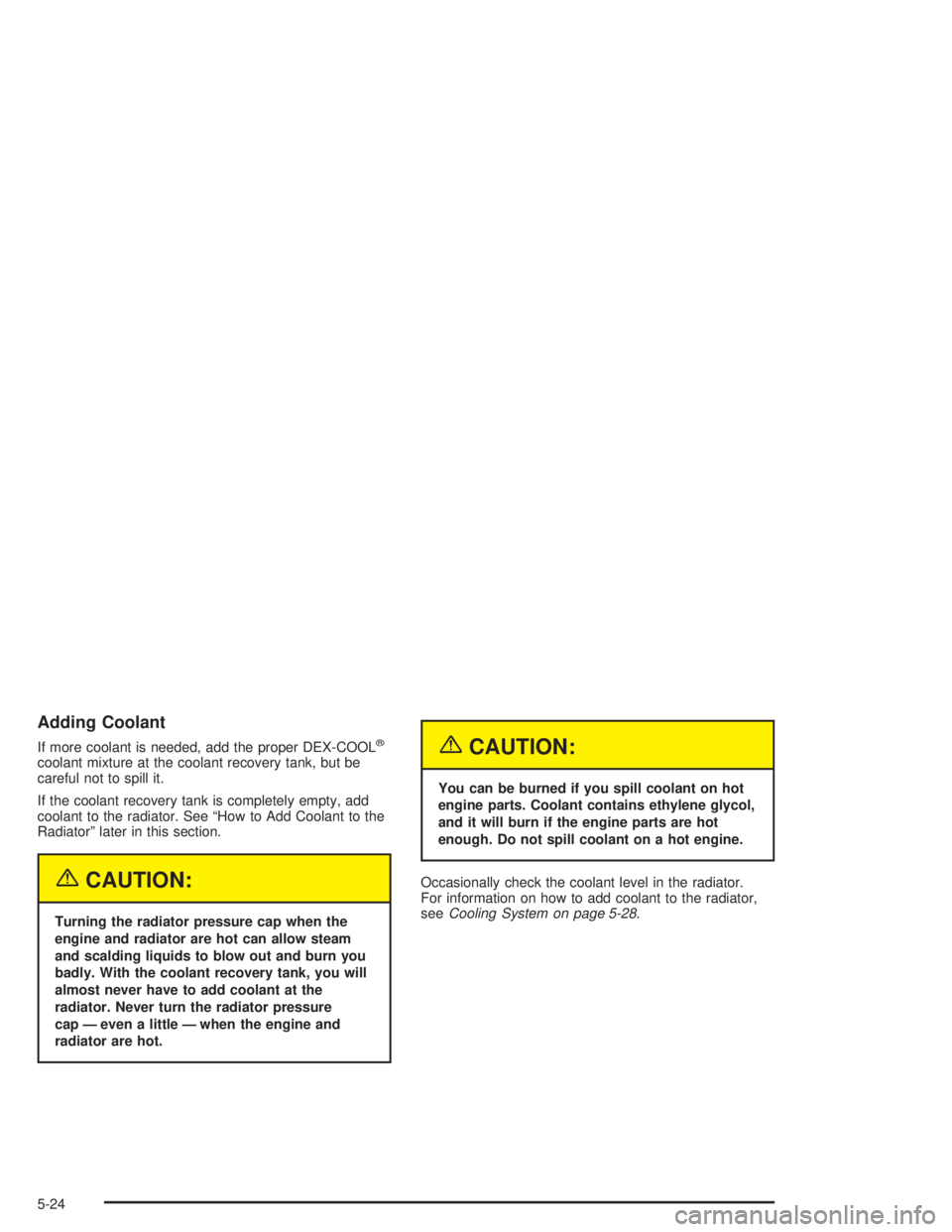
Adding Coolant
If more coolant is needed, add the proper DEX-COOL®
coolant mixture at the coolant recovery tank, but be
careful not to spill it.
If the coolant recovery tank is completely empty, add
coolant to the radiator. See “How to Add Coolant to the
Radiator” later in this section.
{CAUTION:
Turning the radiator pressure cap when the
engine and radiator are hot can allow steam
and scalding liquids to blow out and burn you
badly. With the coolant recovery tank, you will
almost never have to add coolant at the
radiator. Never turn the radiator pressure
cap — even a little — when the engine and
radiator are hot.
{CAUTION:
You can be burned if you spill coolant on hot
engine parts. Coolant contains ethylene glycol,
and it will burn if the engine parts are hot
enough. Do not spill coolant on a hot engine.
Occasionally check the coolant level in the radiator.
For information on how to add coolant to the radiator,
seeCooling System on page 5-28.
5-24
Page 237 of 358
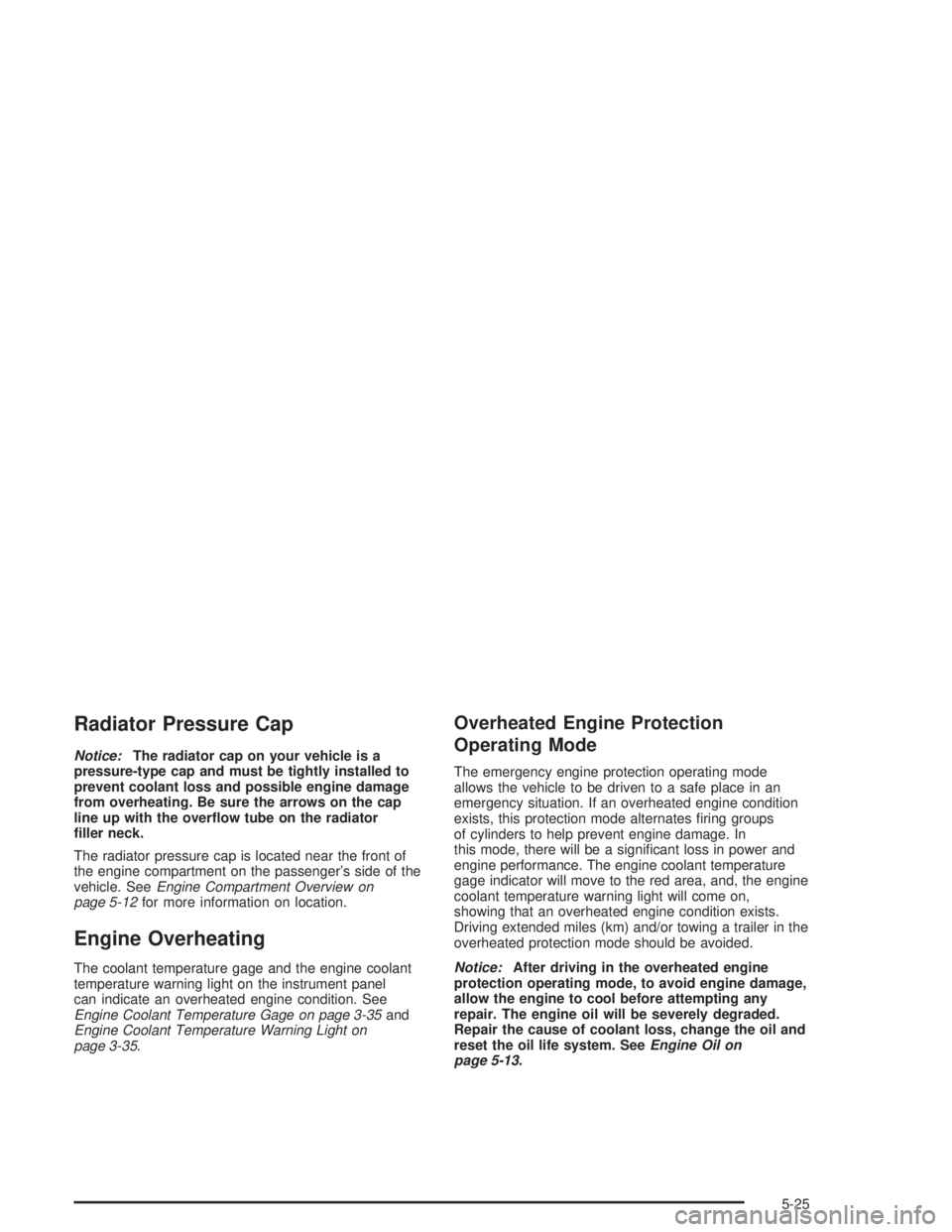
Radiator Pressure Cap
Notice:The radiator cap on your vehicle is a
pressure-type cap and must be tightly installed to
prevent coolant loss and possible engine damage
from overheating. Be sure the arrows on the cap
line up with the over�ow tube on the radiator
�ller neck.
The radiator pressure cap is located near the front of
the engine compartment on the passenger’s side of the
vehicle. SeeEngine Compartment Overview on
page 5-12for more information on location.
Engine Overheating
The coolant temperature gage and the engine coolant
temperature warning light on the instrument panel
can indicate an overheated engine condition. See
Engine Coolant Temperature Gage on page 3-35and
Engine Coolant Temperature Warning Light on
page 3-35.
Overheated Engine Protection
Operating Mode
The emergency engine protection operating mode
allows the vehicle to be driven to a safe place in an
emergency situation. If an overheated engine condition
exists, this protection mode alternates �ring groups
of cylinders to help prevent engine damage. In
this mode, there will be a signi�cant loss in power and
engine performance. The engine coolant temperature
gage indicator will move to the red area, and, the engine
coolant temperature warning light will come on,
showing that an overheated engine condition exists.
Driving extended miles (km) and/or towing a trailer in the
overheated protection mode should be avoided.
Notice:After driving in the overheated engine
protection operating mode, to avoid engine damage,
allow the engine to cool before attempting any
repair. The engine oil will be severely degraded.
Repair the cause of coolant loss, change the oil and
reset the oil life system. SeeEngine Oil on
page 5-13.
5-25
Page 238 of 358
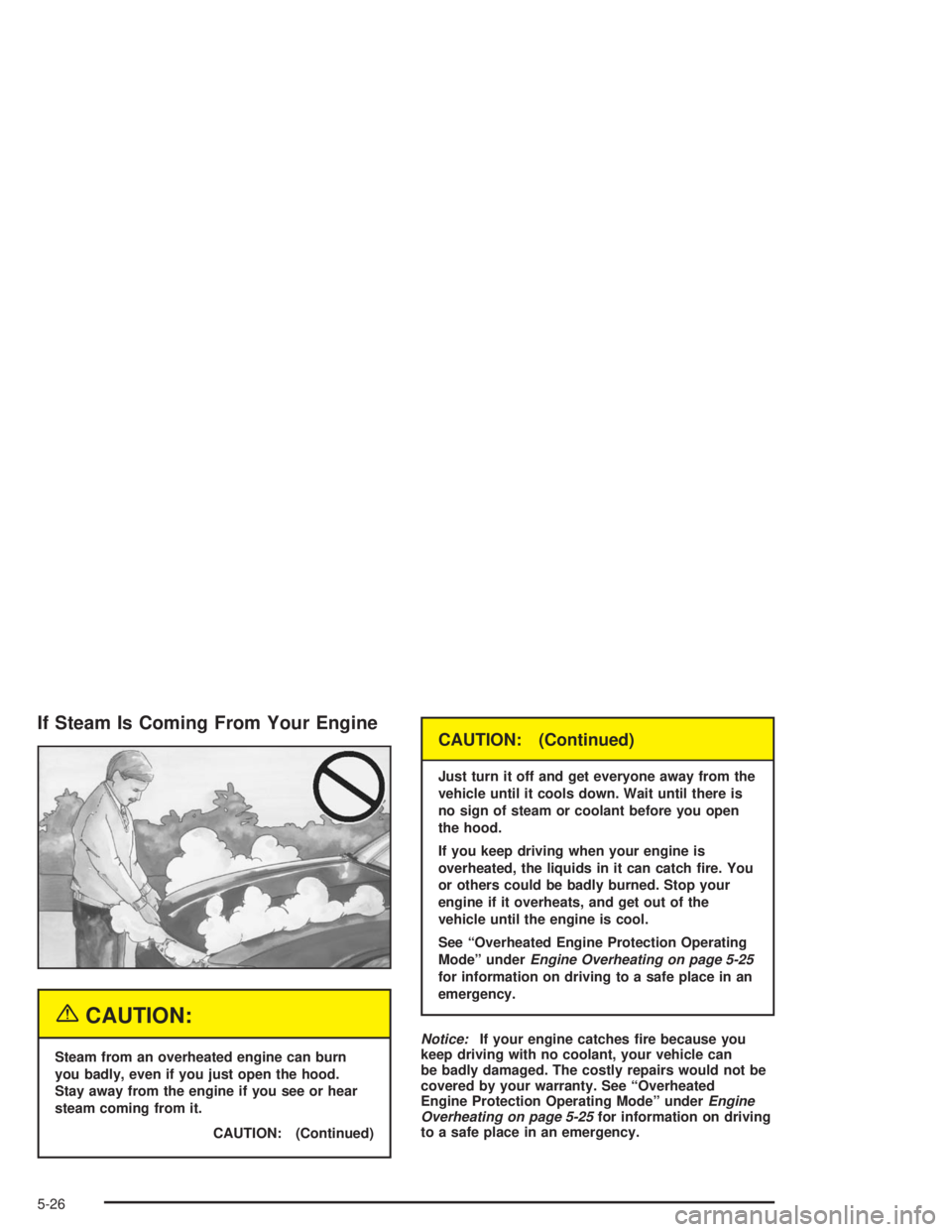
If Steam Is Coming From Your Engine
{CAUTION:
Steam from an overheated engine can burn
you badly, even if you just open the hood.
Stay away from the engine if you see or hear
steam coming from it.
CAUTION: (Continued)
CAUTION: (Continued)
Just turn it off and get everyone away from the
vehicle until it cools down. Wait until there is
no sign of steam or coolant before you open
the hood.
If you keep driving when your engine is
overheated, the liquids in it can catch �re. You
or others could be badly burned. Stop your
engine if it overheats, and get out of the
vehicle until the engine is cool.
See “Overheated Engine Protection Operating
Mode” underEngine Overheating on page 5-25
for information on driving to a safe place in an
emergency.
Notice:If your engine catches �re because you
keep driving with no coolant, your vehicle can
be badly damaged. The costly repairs would not be
covered by your warranty. See “Overheated
Engine Protection Operating Mode” underEngine
Overheating on page 5-25for information on driving
to a safe place in an emergency.
5-26
Page 240 of 358
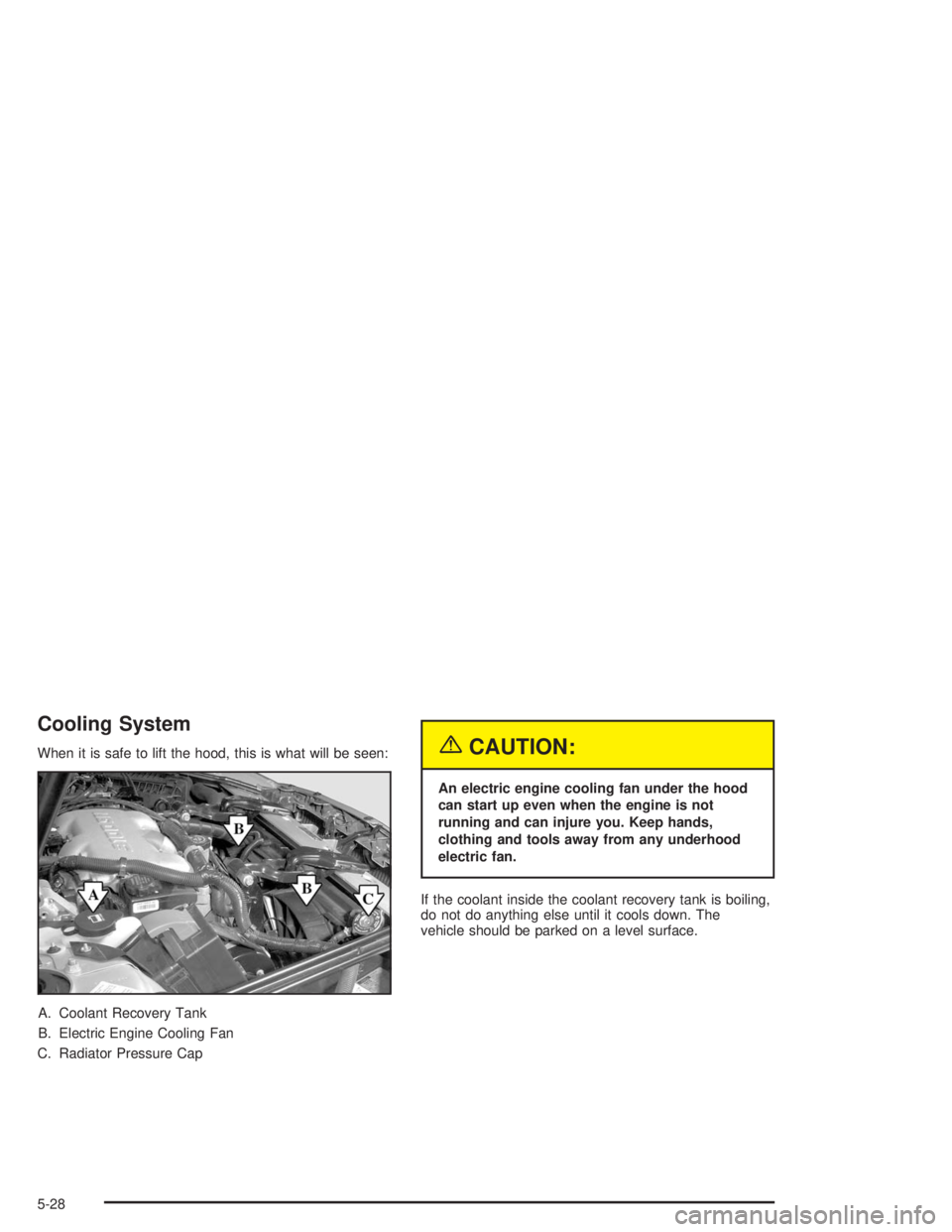
Cooling System
When it is safe to lift the hood, this is what will be seen:
A. Coolant Recovery Tank
B. Electric Engine Cooling Fan
C. Radiator Pressure Cap{CAUTION:
An electric engine cooling fan under the hood
can start up even when the engine is not
running and can injure you. Keep hands,
clothing and tools away from any underhood
electric fan.
If the coolant inside the coolant recovery tank is boiling,
do not do anything else until it cools down. The
vehicle should be parked on a level surface.
5-28
Page 241 of 358
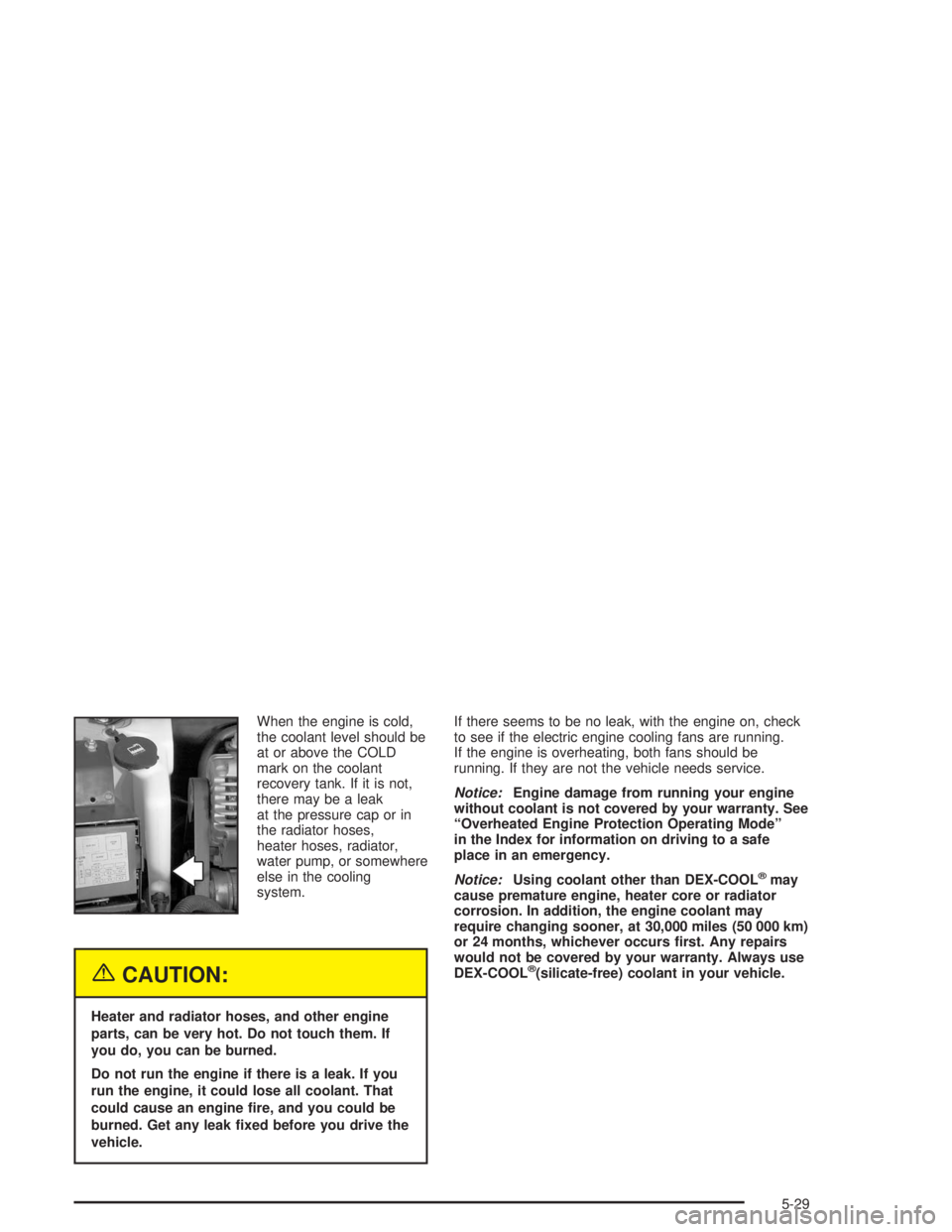
When the engine is cold,
the coolant level should be
at or above the COLD
mark on the coolant
recovery tank. If it is not,
there may be a leak
at the pressure cap or in
the radiator hoses,
heater hoses, radiator,
water pump, or somewhere
else in the cooling
system.
{CAUTION:
Heater and radiator hoses, and other engine
parts, can be very hot. Do not touch them. If
you do, you can be burned.
Do not run the engine if there is a leak. If you
run the engine, it could lose all coolant. That
could cause an engine �re, and you could be
burned. Get any leak �xed before you drive the
vehicle.If there seems to be no leak, with the engine on, check
to see if the electric engine cooling fans are running.
If the engine is overheating, both fans should be
running. If they are not the vehicle needs service.
Notice:Engine damage from running your engine
without coolant is not covered by your warranty. See
“Overheated Engine Protection Operating Mode”
in the Index for information on driving to a safe
place in an emergency.
Notice:Using coolant other than DEX-COOL
®may
cause premature engine, heater core or radiator
corrosion. In addition, the engine coolant may
require changing sooner, at 30,000 miles (50 000 km)
or 24 months, whichever occurs �rst. Any repairs
would not be covered by your warranty. Always use
DEX-COOL
®(silicate-free) coolant in your vehicle.
5-29
Page 242 of 358
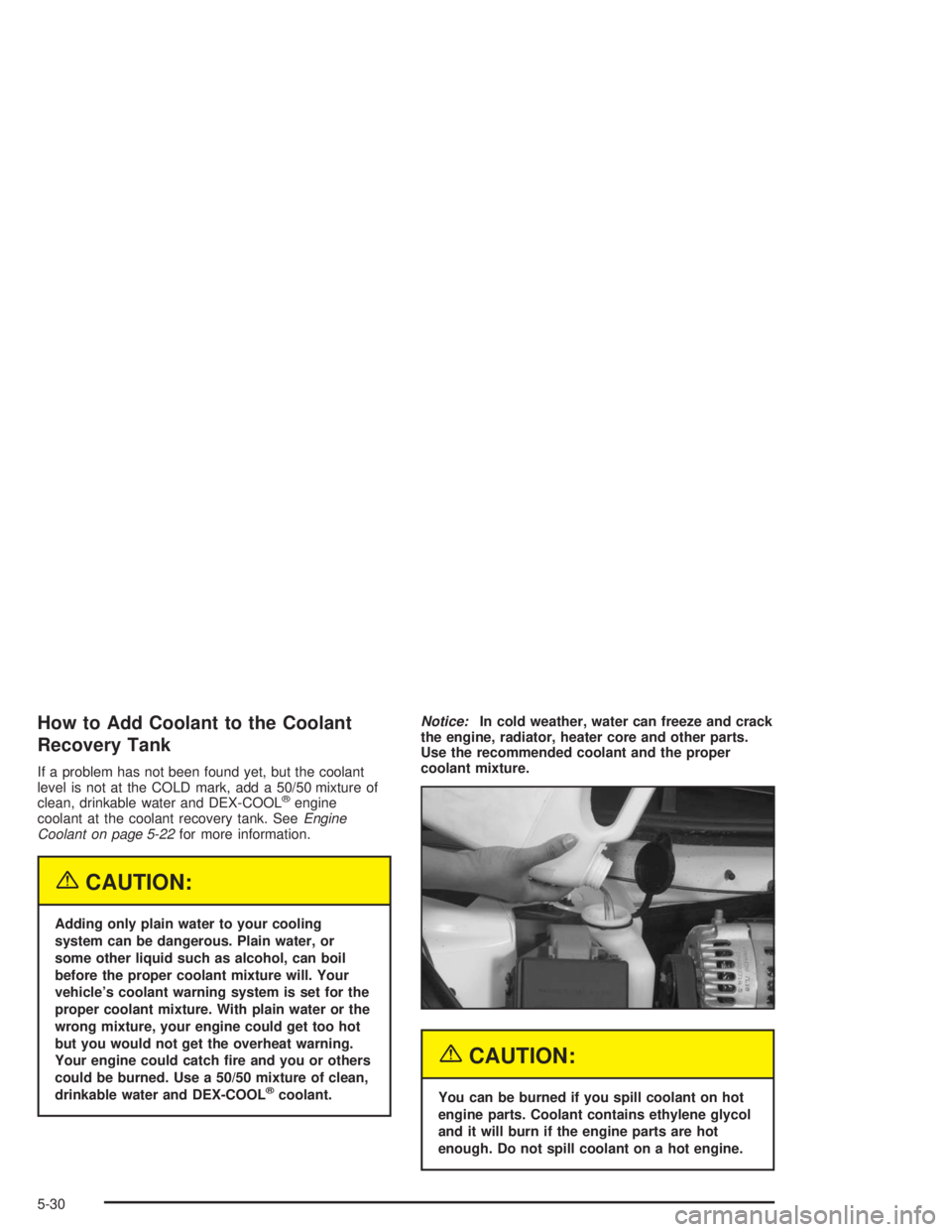
How to Add Coolant to the Coolant
Recovery Tank
If a problem has not been found yet, but the coolant
level is not at the COLD mark, add a 50/50 mixture of
clean, drinkable water and DEX-COOL
®engine
coolant at the coolant recovery tank. SeeEngine
Coolant on page 5-22for more information.
{CAUTION:
Adding only plain water to your cooling
system can be dangerous. Plain water, or
some other liquid such as alcohol, can boil
before the proper coolant mixture will. Your
vehicle’s coolant warning system is set for the
proper coolant mixture. With plain water or the
wrong mixture, your engine could get too hot
but you would not get the overheat warning.
Your engine could catch �re and you or others
could be burned. Use a 50/50 mixture of clean,
drinkable water and DEX-COOL
®coolant.Notice:In cold weather, water can freeze and crack
the engine, radiator, heater core and other parts.
Use the recommended coolant and the proper
coolant mixture.
{CAUTION:
You can be burned if you spill coolant on hot
engine parts. Coolant contains ethylene glycol
and it will burn if the engine parts are hot
enough. Do not spill coolant on a hot engine.
5-30
Page 243 of 358
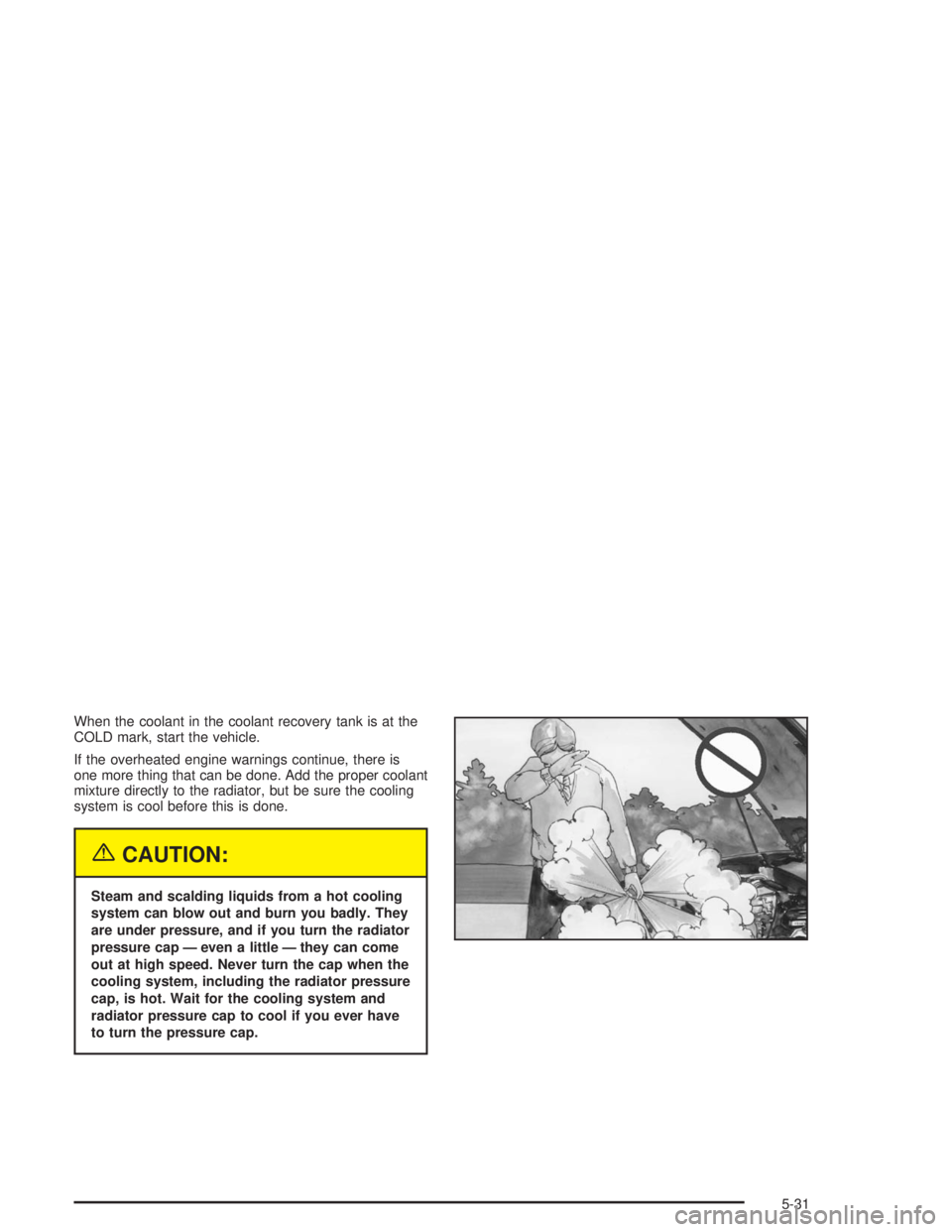
When the coolant in the coolant recovery tank is at the
COLD mark, start the vehicle.
If the overheated engine warnings continue, there is
one more thing that can be done. Add the proper coolant
mixture directly to the radiator, but be sure the cooling
system is cool before this is done.
{CAUTION:
Steam and scalding liquids from a hot cooling
system can blow out and burn you badly. They
are under pressure, and if you turn the radiator
pressure cap — even a little — they can come
out at high speed. Never turn the cap when the
cooling system, including the radiator pressure
cap, is hot. Wait for the cooling system and
radiator pressure cap to cool if you ever have
to turn the pressure cap.
5-31
Page 244 of 358
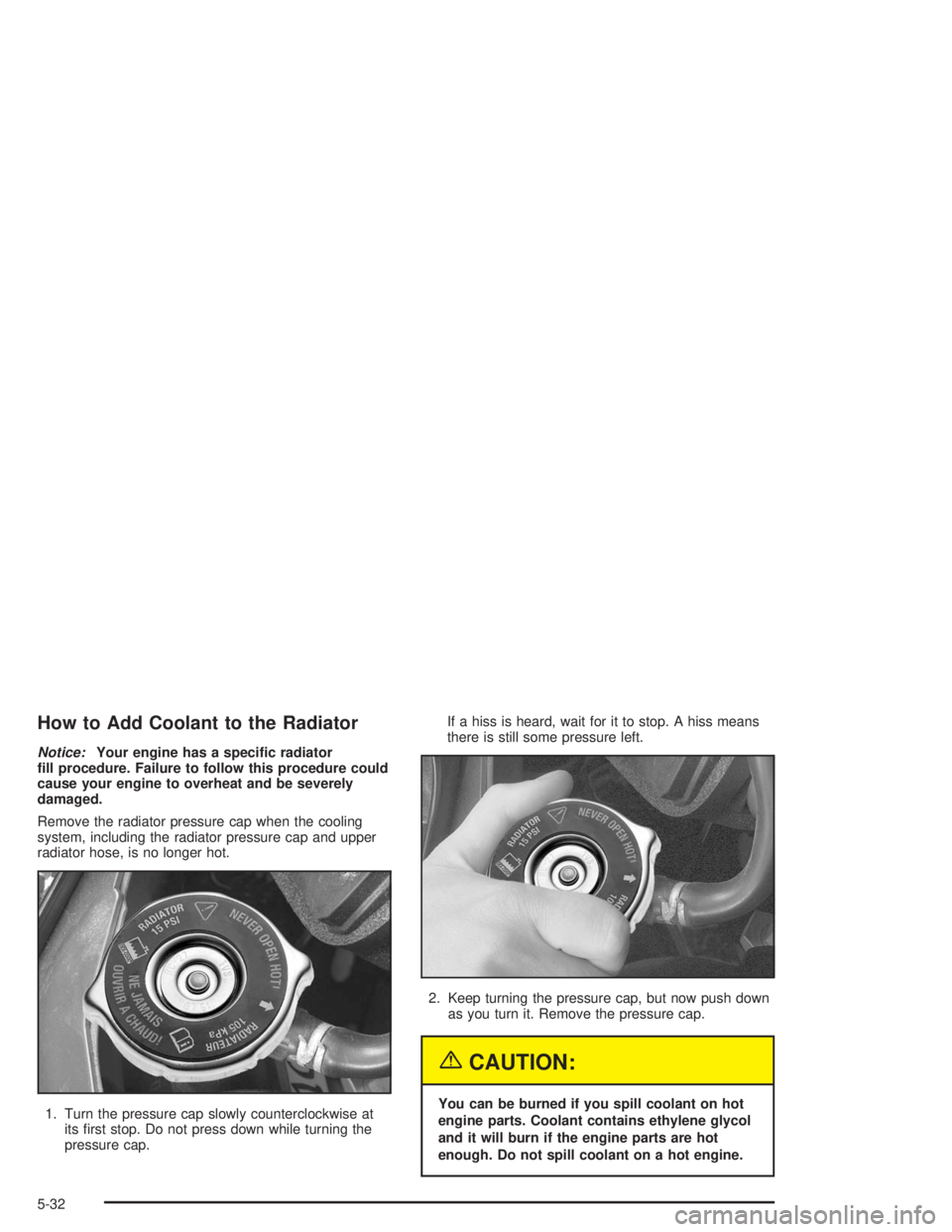
How to Add Coolant to the Radiator
Notice:Your engine has a speci�c radiator
�ll procedure. Failure to follow this procedure could
cause your engine to overheat and be severely
damaged.
Remove the radiator pressure cap when the cooling
system, including the radiator pressure cap and upper
radiator hose, is no longer hot.
1. Turn the pressure cap slowly counterclockwise at
its �rst stop. Do not press down while turning the
pressure cap.If a hiss is heard, wait for it to stop. A hiss means
there is still some pressure left.
2. Keep turning the pressure cap, but now push down
as you turn it. Remove the pressure cap.
{CAUTION:
You can be burned if you spill coolant on hot
engine parts. Coolant contains ethylene glycol
and it will burn if the engine parts are hot
enough. Do not spill coolant on a hot engine.
5-32
Page 245 of 358
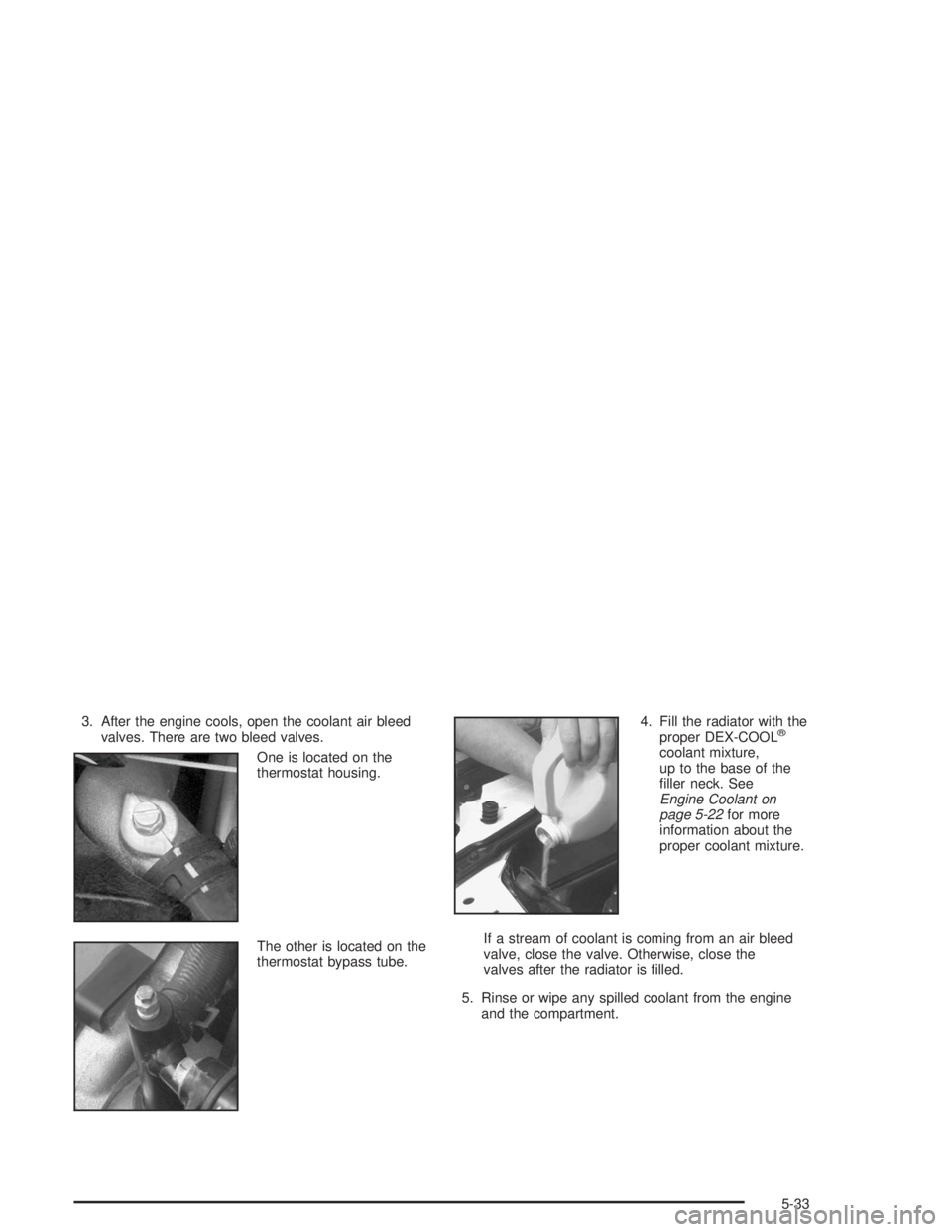
3. After the engine cools, open the coolant air bleed
valves. There are two bleed valves.
One is located on the
thermostat housing.
The other is located on the
thermostat bypass tube.4. Fill the radiator with the
proper DEX-COOL®
coolant mixture,
up to the base of the
�ller neck. See
Engine Coolant on
page 5-22for more
information about the
proper coolant mixture.
If a stream of coolant is coming from an air bleed
valve, close the valve. Otherwise, close the
valves after the radiator is �lled.
5. Rinse or wipe any spilled coolant from the engine
and the compartment.
5-33
Page 246 of 358
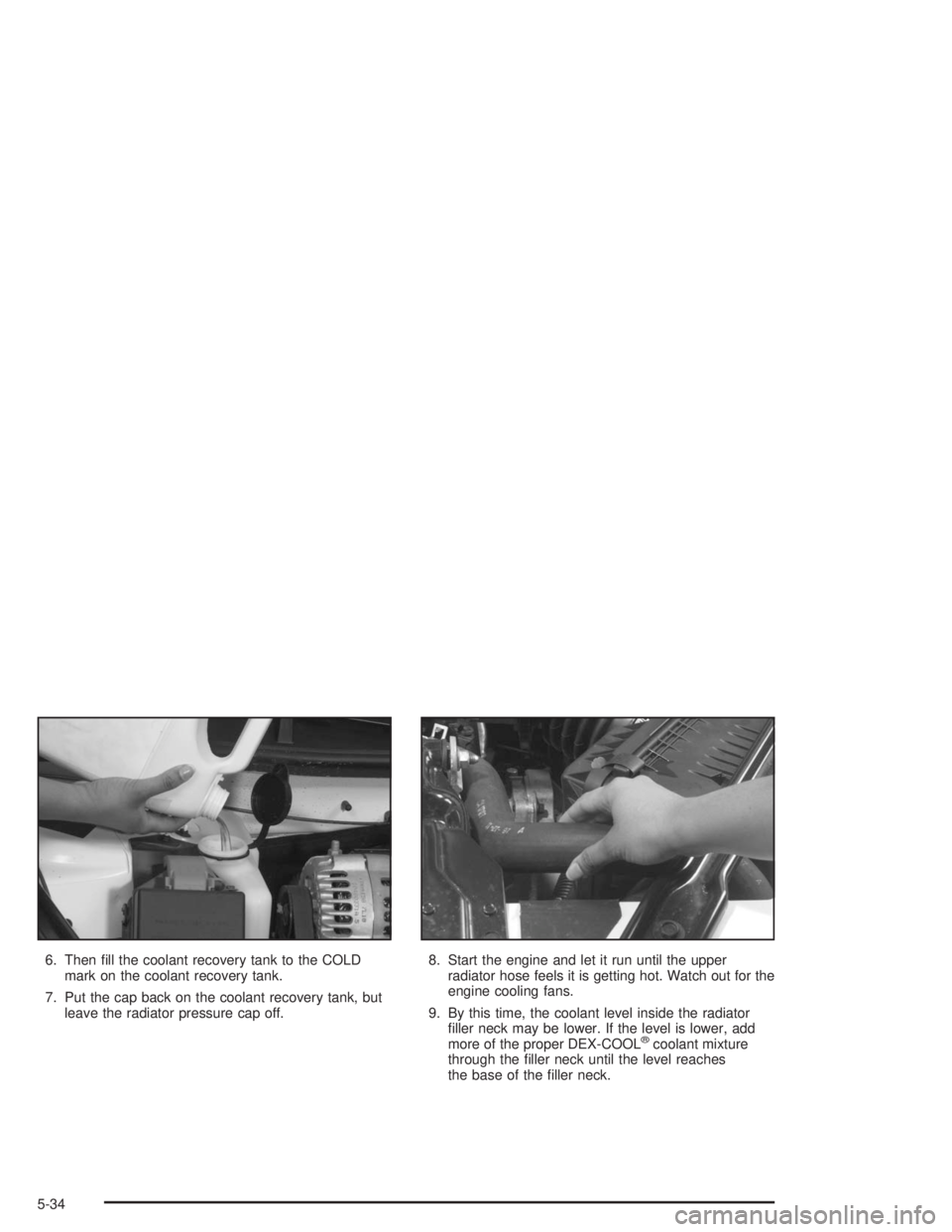
6. Then �ll the coolant recovery tank to the COLD
mark on the coolant recovery tank.
7. Put the cap back on the coolant recovery tank, but
leave the radiator pressure cap off.8. Start the engine and let it run until the upper
radiator hose feels it is getting hot. Watch out for the
engine cooling fans.
9. By this time, the coolant level inside the radiator
�ller neck may be lower. If the level is lower, add
more of the proper DEX-COOL
®coolant mixture
through the �ller neck until the level reaches
the base of the �ller neck.
5-34